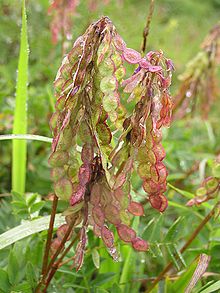Sweet clover
| Sweet clover | ||||||||||||
|---|---|---|---|---|---|---|---|---|---|---|---|---|

Alpine sweet clover ( Hedysarum hedysaroides ), illustration |
||||||||||||
| Systematics | ||||||||||||
|
||||||||||||
| Scientific name | ||||||||||||
| Hedysarum | ||||||||||||
| L. |
The sweet clover ( Hedysarum ) is a genus of plants from the subfamily of the butterflies (Faboideae), the only Central European representative of which is the Alpine sweet clover .
description
These are annual, biennial or perennial herbaceous plants or even deciduous shrubs with soft wood.
The leaves are pinnate unpaired and are reminiscent of the leaves of vetch . However, the terminal leaflet is developed and not shaped into a tendril. In some species, the leaves are also strongly receded.

The flowers are in terminal, more or less dense and narrow spiked or racemose inflorescences , which are also reminiscent of vetches. The flower color of most species is red, pink or purple. The name of the genus refers to the sweet scent of the flowers. The hermaphrodite flowers are zygomorphic .

Like the other species of the tribe Hedysareae , all sweet clover species form articulated pods as fruits. H. Pods which do not open lengthways, but which, after ripening, disintegrate transversely into individual links.
Distribution and location requirements
The genus has its development center in the intra-Asia s drylands . Other species occur in the Mediterranean region (including North Africa), in Western Asia and in North America , and a few species also in the temperate part of Europe .
The majority of the species prefer open, dry locations such as steppes , deserts or grasslands . Some species also grow on coasts and are quite tolerant of salt .


Types (selection)
The approximately 100 species of the genus include some valuable forage plants as well as some ornamental plants . Here is a selection:
- Hedysarum algidum L. Z. Shue : It occurs in two varieties in China in the provinces of Gansu, Qinghai, Sichuan, Xizang and Yunnan at altitudes between 3000 and 4500 meters.
- Wild potato ( Hedysarum alpinum L. ): It occurs in three varieties from European Russia and in the temperate zones of Asia from China to East Asia, as well as in Pakistan, India, Canada and the USA.
- Hedysarum boreale Nutt. : It occurs in two subspecies and two varieties in Siberia, East Asia, Canada and the USA.
- Whitish sweet clover ( Hedysarum boutignyanum (A. Camus) Alleiz. ): It occurs only in the French southwestern Alps.
- Briançon sweet clover ( Hedysarum brigantiacum Bourn., Chas & Kerguélen ): This sweet clover, which was only described as a new species in 1992, occurs in the French southwestern Alps.
- Fleshy sweet clover ( Hedysarum carnosum Desf. ): It occurs in Morocco, Algeria and Tunisia.
- Spanish Esparsette ( Hedysarum coronarium L. ), also known as crown sweet clover, sulla or Italian cock's head, a Mediterranean species that is sometimes cultivated as an ornamental plant. Her homeland is Spain, Morocco, Algeria and Tunisia. But it is also naturalized in southern Europe and Lebanon.
- Hedysarum flexuosum L .: It occurs in southwest Portugal, southwest Spain, Morocco, Algeria and Tunisia.
- Hedysarum glomeratum F. Dietr. (Syn .: Hedysarum spinosissimum subsp. Capitatum (Rouy) Asch. & Graebn. ): The home is southern Europe, Morocco, Algeria, Tunisia and Libya.
- Hedysarum gmelinii Ledeb. : It occurs in China, Mongolia, Central Asia and Siberia.
- Large-flowered sweet clover ( Hedysarum grandiflorum Pall. ): Its home is in Eastern and Southeastern Europe as well as in western Siberia and Kazakhstan.
- Alpine sweet clover ( Hedysarum hedysaroides (L.) Schinz & Thell .; Syn .: Hedysarum obscurum L. ), the only Central European species. It occurs in Europe and West Asia.
- Mongolian sweet clover ( Hedysarum multijugum Maxim. ): It occurs in Mongolia and western China.
- Thorny sweet clover ( Hedysarum spinosissimum L. ): It is native to southern Europe, North Africa and western Asia.
- Hedysarum tauricum Pall. ex Willd. : It occurs in northeastern Bulgaria, in the Crimea and in the Caucasus.
ingredients
The effects of coumarins were discovered when a livestock disease developed in Canada and the USA, which was characterized by an increased tendency to bleed. The cause could always be determined that the cattle had eaten spoiled sweet clover. About 40 substances with Vit-K antagonist properties were isolated from this feed alone.
Sources and further information
literature
- Gordon Cheers (Ed.): Botanica . Random House Australia 2003. German edition: Tandem Verlag GmbH 2003, ISBN 3-8331-1600-5 .
- Urania plant kingdom . Volume 3: Flowering Plants 1, 1st edition. Urania-Verlag, Leipzig 1991, ISBN 3-332-00367-4 .
- Notes on the taxonomy of Hedysarum (Fabaceae) in Iran ( PDF )
supporting documents
- ↑ a b c d e f g h i j k l m Hedysarum in the Germplasm Resources Information Network (GRIN), USDA , ARS , National Genetic Resources Program. National Germplasm Resources Laboratory, Beltsville, Maryland.
- ↑ Langran Xu & Byoung-Hee Choi: Hedysarum In: Flora of China . Volume 10, page 512. Hedysarum in Flora of China - efloras.org
- ↑ A. Chrtková-Žertová: Hedysarum L. In: Thomas Gaskell Tutin u. a .: Flora Europaea . Volume 2, pages 185-187. Cambridge University Press 1968.
- ↑ David Aeschimann, Konrad Lauber, Daniel Martin Moser, Jean-Paul Theurillat: Flora alpina. An atlas of all 4500 vascular plants in the Alps . Volume 1, page 952. Haupt Verlag, Bern, Stuttgart, Vienna 2004. ISBN 3-258-06600-0

